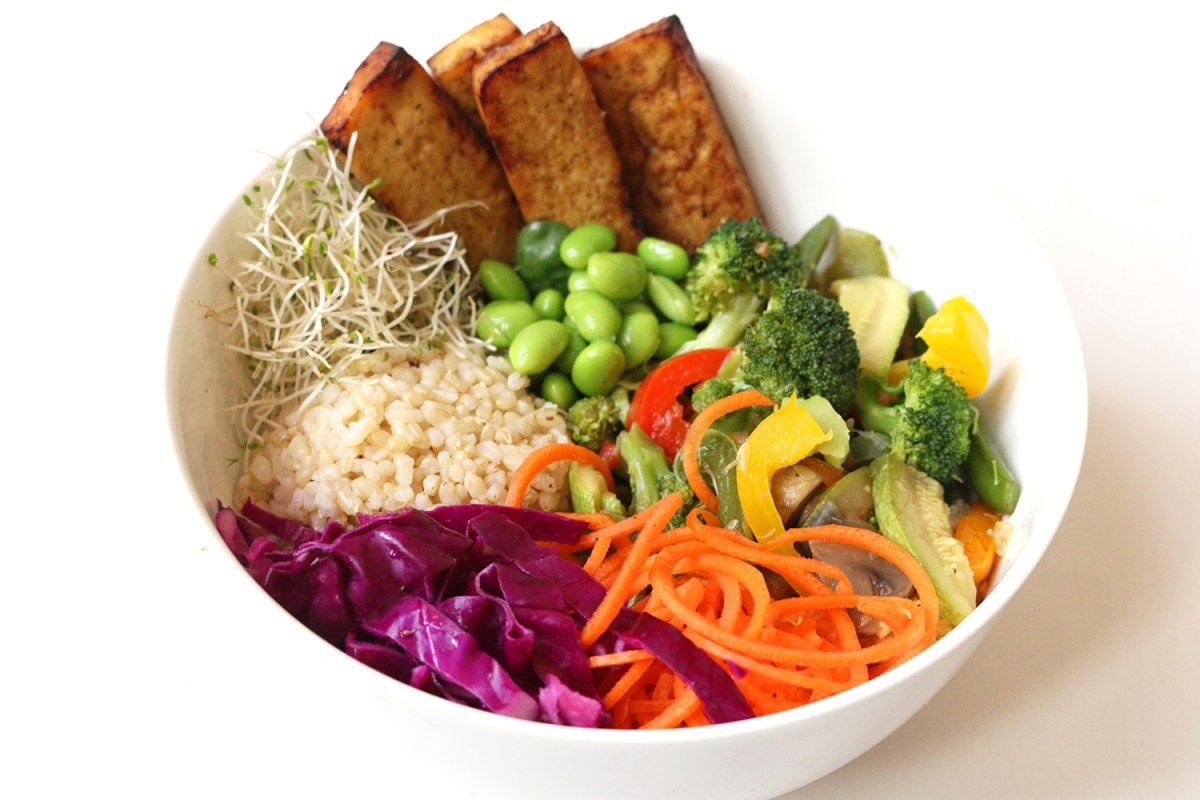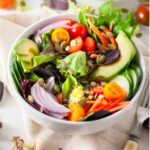Embark on a culinary journey through Asia without leaving your kitchen! This exploration of vibrant, plant-based bowls showcases the diverse and delicious flavors of various Asian cuisines. From the delicate umami of Japan to the fiery spice of Thailand, each recipe offers a unique sensory experience, brimming with fresh, colorful ingredients and satisfying textures. Prepare to be captivated by the ease of preparation and the incredible depth of flavor achievable with these vegan masterpieces.
We’ll delve into five distinct Asian-inspired vegan bowl recipes, providing detailed step-by-step instructions, ingredient sourcing tips, and nutritional information. Learn the art of stir-frying, steaming, and marinating to create bowls that are not only visually stunning but also bursting with wholesome goodness. Discover how to elevate your presentation with thoughtful garnishes and serving suggestions, transforming a simple meal into a truly memorable dining experience.
Step-by-Step Cooking Instructions

This section provides a detailed guide for preparing a vibrant and flavorful Peanut Noodles with Roasted Vegetables and Tofu bowl. This recipe showcases the beauty of simple cooking techniques to create a complex and satisfying meal. The combination of textures and tastes is designed to tantalize your palate and leave you feeling nourished and energized.
Preparing the Roasted Vegetables
Roasting the vegetables brings out their natural sweetness and creates a delightful caramelization. This process is simple yet crucial for the bowl’s overall success.
- Preheat your oven to 400°F (200°C). Line a baking sheet with parchment paper for easy cleanup.
- Chop 1 cup of broccoli florets, 1 cup of bell peppers (any color), and 1/2 cup of red onion into bite-sized pieces. Toss them in a bowl with 1 tablespoon of olive oil, 1/2 teaspoon of salt, and 1/4 teaspoon of black pepper.
- Spread the vegetables in a single layer on the prepared baking sheet. Ensure they aren’t overcrowded to promote even roasting.
- Roast for 20-25 minutes, or until the vegetables are tender and slightly browned, flipping halfway through for even cooking. The edges should exhibit a rich, almost-burnt appearance for maximum flavor.
Preparing the Tofu
Pressing the tofu removes excess water, resulting in a firmer texture that crisps beautifully when pan-fried.
- Press 1 block (14 oz) of extra-firm tofu to remove excess water. Wrap it in a clean kitchen towel or paper towels and place a heavy object (like books) on top for at least 15 minutes.
- Cut the pressed tofu into bite-sized cubes.
- Heat 1 tablespoon of olive oil in a large skillet over medium-high heat. Add the tofu cubes and cook, stirring occasionally, until golden brown and crispy on all sides (about 8-10 minutes). The sound of sizzling and the visible browning are clear indicators of successful cooking.
Making the Peanut Sauce
The peanut sauce is the heart of this bowl, binding all the elements together with its creamy, savory, and slightly spicy profile.
- In a small bowl, whisk together 1/4 cup of peanut butter (smooth or crunchy), 2 tablespoons of soy sauce (or tamari for gluten-free), 2 tablespoons of rice vinegar, 1 tablespoon of maple syrup, 1 tablespoon of sesame oil, 1 tablespoon of water, and 1/2 teaspoon of sriracha (or more, to taste). The sauce should be smooth and pourable; adjust water consistency as needed.
- Taste and adjust seasonings as needed. You can add more soy sauce for saltiness, maple syrup for sweetness, or sriracha for heat.
Assembling the Bowl
The final step involves bringing all the components together for a visually appealing and flavorful meal.
- Cook 8 ounces of your preferred noodles according to package directions. Drain and rinse with cold water to prevent sticking.
- Divide the cooked noodles among bowls. Top with the roasted vegetables, crispy tofu, and a generous drizzle of the peanut sauce.
- Garnish with chopped peanuts, sesame seeds, and fresh cilantro (optional) for added visual appeal and flavor complexity. The vibrant greens of cilantro contrast beautifully with the other elements.
Tips and Tricks for Optimal Results
- For a quicker meal, use pre-cut vegetables. The time saved can be used to focus on other aspects of the dish.
- If you don’t have peanut butter, you can substitute with tahini for a similar nutty flavor profile. Tahini offers a slightly different texture and taste, making it a viable alternative.
- Add a squeeze of lime juice to the peanut sauce for extra brightness and acidity. This elevates the overall flavor profile.
- For a spicier kick, add a pinch of red pepper flakes to the peanut sauce or vegetables. The subtle heat complements the other flavors.
- Feel free to add other vegetables like carrots, zucchini, or mushrooms. The recipe is highly adaptable to personal preferences and seasonal availability.
Ingredient Sourcing and Preparation
The foundation of any truly delicious Asian-inspired vegan bowl lies in the quality and freshness of its ingredients. Using vibrant, seasonal produce and carefully selected pantry staples elevates these bowls from simply nutritious to genuinely exquisite. The subtle nuances of flavor and the delightful textural contrasts are directly linked to the quality of your ingredients. Taking the time to source thoughtfully and prepare meticulously will reward you with a bowl that’s both satisfying and memorable.
The selection and preparation of key ingredients significantly impact the final taste and texture of your vegan bowl. Consider the visual appeal as well; vibrant colors and appealing textures contribute significantly to the overall dining experience. A thoughtfully arranged bowl is as pleasing to the eye as it is to the palate.
Ingredient Selection and Preparation Guide
The following table details optimal sourcing and preparation techniques for key ingredients, emphasizing methods to maximize flavor and texture.
| Ingredient | Sourcing Tips | Preparation Steps | Flavor Enhancement Techniques |
|---|---|---|---|
| Tofu | Choose firm or extra-firm tofu for its ability to hold its shape during cooking. Look for organic and non-GMO options. | Press tofu to remove excess water for a firmer texture. Cut into cubes or slices depending on the recipe. Marinate in soy sauce, ginger, and garlic for added flavor. | Pan-frying, baking, or air-frying tofu until golden brown creates a delightful crispy exterior. Marinating enhances flavor significantly. |
| Noodles | Select noodles based on your desired texture and the overall flavor profile of your bowl. Consider rice noodles, soba noodles, or udon noodles. Look for brands with minimal additives. | Cook noodles according to package directions. Rinse with cold water to prevent sticking. Toss with a small amount of oil to prevent clumping. | Tossing cooked noodles with a flavorful sauce or a combination of sesame oil, soy sauce, and rice vinegar adds depth and complexity. |
| Vegetables | Choose seasonal vegetables for optimal flavor and nutritional value. Look for brightly colored, firm vegetables with no blemishes. | Wash and chop vegetables according to the recipe. Blanching or stir-frying vegetables helps retain their vibrant color and crispness. | Roasting vegetables brings out their natural sweetness. Adding a touch of toasted sesame oil or a sprinkle of chili flakes enhances their flavor. |
| Sauces | Consider using high-quality soy sauce, tamari (gluten-free soy sauce), rice vinegar, sesame oil, and other Asian-inspired sauces. Look for brands with minimal added sugar and preservatives. | Combine sauces according to your recipe. Taste and adjust seasonings as needed. A well-balanced sauce is crucial for a delicious bowl. | Infusing sauces with fresh ginger, garlic, or chili adds depth and complexity. A touch of sweetness from maple syrup or agave nectar can balance savory flavors. |
Nutritional Information and Health Benefits
These Asian-inspired vegan bowls are designed not only to tantalize your taste buds but also to nourish your body with a vibrant array of vitamins, minerals, and antioxidants. Each recipe provides a complete and balanced meal, contributing to overall health and well-being. The focus is on whole, unprocessed ingredients, maximizing nutritional value while minimizing empty calories.
Each bowl is carefully crafted to offer a diverse range of nutrients essential for optimal health. The combinations of vegetables, grains, legumes, and flavorful sauces create a synergistic effect, enhancing the bioavailability and absorption of key nutrients. This section details the nutritional profile and health benefits of several example recipes.
Nutritional Breakdown of Featured Recipes
The following table summarizes the nutritional information and health benefits of three example recipes, offering a glimpse into the wholesome nature of these Asian-inspired vegan bowls. Note that calorie counts are approximate and may vary based on specific ingredients and portion sizes.
| Recipe | Calories (approx.) | Key Nutrients | Health Benefits |
|---|---|---|---|
| Spicy Peanut Noodles with Edamame and Tofu | 450-550 | Protein (from tofu and edamame), fiber (from noodles and vegetables), iron (from edamame), Vitamin B (from tofu), healthy fats (from peanut butter) | Supports muscle growth and repair, promotes healthy digestion, aids in iron absorption, boosts energy levels, contributes to heart health. |
| Ginger-Glazed Shiitake Mushroom and Quinoa Bowl | 380-480 | Fiber (from quinoa and mushrooms), antioxidants (from shiitake mushrooms and ginger), vitamin D (from mushrooms if exposed to UV light during growth), complex carbohydrates (from quinoa), potassium (from mushrooms) | Promotes satiety, supports gut health, protects against cell damage, provides sustained energy release, supports healthy blood pressure. |
| Vietnamese-Style Summer Rolls with Peanut Sauce | 250-350 | Vitamin A (from carrots and other vegetables), Vitamin C (from various vegetables), fiber (from rice noodles and vegetables), antioxidants (from various vegetables and herbs), healthy fats (from peanut sauce) | Supports immune function, improves vision, promotes healthy digestion, protects against cell damage, contributes to overall well-being. |
Presentation and Serving Suggestions
Elevating your Asian-inspired vegan bowls from a simple meal to a captivating culinary experience hinges on thoughtful presentation. The visual appeal of your creation significantly impacts the overall dining experience, transforming a nourishing meal into a feast for the eyes as well as the palate. Careful consideration of bowl selection, garnishes, and table setting creates an ambiance that enhances the enjoyment of your delicious and healthy vegan bowls.
The art of presentation lies in highlighting the vibrant colors and textures of the ingredients. Think of your bowl as a canvas, and each element – from the perfectly cooked noodles to the colorful vegetables – as a brushstroke contributing to a harmonious and appetizing masterpiece. A well-presented bowl not only looks delicious but also suggests a level of care and attention to detail that elevates the entire dining experience.
Bowl Selection and Garnishes
Choosing the right bowl is crucial. A shallow, wide bowl allows for a visually appealing arrangement of ingredients, showcasing the diverse colors and textures. Consider bowls made from natural materials like bamboo or ceramic for an authentic Asian feel. The color of the bowl itself can also enhance the overall aesthetic; a neutral-toned bowl will allow the vibrant colors of your ingredients to shine, while a darker bowl can create a more dramatic presentation. Garnishes are the finishing touch, adding a pop of color and texture. Fresh herbs like cilantro, mint, or basil, strategically placed, add a touch of freshness and visual interest. A sprinkle of toasted sesame seeds provides a textural contrast and subtle nutty flavor. Thinly sliced red chilies (if desired) add a vibrant splash of color and a hint of spice. Consider edible flowers, like pansies or nasturtiums, for a sophisticated and unexpected touch. Imagine a bowl of vibrant green noodles nestled amongst jewel-toned peppers and carrots, crowned with a scattering of bright green cilantro and a delicate sprinkle of sesame seeds. The contrast in colors and textures creates a visually stunning and appetizing presentation.
Complementary Side Dishes and Beverages
Complementary side dishes can elevate the dining experience and offer a balanced meal. A simple side salad with a light vinaigrette, featuring fresh greens and perhaps some crunchy elements like edamame or toasted nuts, adds freshness and lightness. Kimchi, with its spicy and fermented tang, offers a contrasting flavor profile and adds textural complexity. Alternatively, a small bowl of steamed rice or quinoa provides a neutral base to complement the more intense flavors of the bowl. Beverage pairings should complement the flavors of the bowl without overpowering them. Green tea, with its subtle bitterness and refreshing qualities, is a classic pairing. A light and crisp white wine, such as Sauvignon Blanc, can also complement the fresh flavors of the bowl, especially if it features citrusy notes. For a non-alcoholic option, consider a refreshing cucumber or ginger-infused water.
Table Setting and Ambiance
The table setting plays a significant role in creating the overall dining experience. A clean, uncluttered table sets the stage for a visually appealing meal. Use a simple placemat, perhaps in a natural material like bamboo or woven fabric, to anchor the bowl and add a touch of texture. Simple, elegant chopsticks add to the Asian theme, and a small bowl for dipping sauces adds a touch of refinement. Soft lighting, whether from candles or a dimmed overhead light, creates a warm and inviting ambiance. Consider incorporating elements of Asian-inspired décor, such as a simple vase with a few sprigs of bamboo or a small Buddha statue, to enhance the overall theme. Imagine the bowl resting on a natural fiber placemat, surrounded by the soft glow of candlelight, the aroma of the dish filling the air. This carefully curated atmosphere elevates the simple act of eating into a mindful and enjoyable experience.
These Asian-inspired vegan bowls are more than just meals; they are a celebration of vibrant flavors, textures, and culinary traditions. From the satisfying crunch of fresh vegetables to the rich depth of flavorful sauces, each bowl is a testament to the power of plant-based cuisine. With a little creativity and the guidance provided, you can easily recreate these delicious and healthy bowls in your own kitchen, delighting yourself and your guests with a truly unforgettable culinary adventure. So, gather your ingredients, embrace the process, and prepare to be amazed by the incredible results!
Top FAQs
Can I substitute ingredients in these recipes?
Absolutely! Many ingredients can be swapped based on preference or availability. The recipes provide suggestions for substitutions where appropriate.
How long do these bowls keep in the refrigerator?
These bowls generally keep well for 3-4 days in an airtight container in the refrigerator. However, for optimal freshness and texture, it’s best to enjoy them within 2 days.
Are these recipes gluten-free?
Most of these recipes can be made gluten-free by using gluten-free noodles and tamari or coconut aminos instead of soy sauce. Always check ingredient labels to ensure gluten-free status.
Can I make these bowls ahead of time?
Many components of these bowls can be prepped in advance, such as chopping vegetables and making sauces. Assemble the bowls just before serving for optimal freshness and texture.


